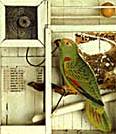DEAR Madam/Sir
"Complements of the day, before I proceed, I must be grateful to introduce myself. I am Mrs Gaylene Hopsack, the bereaving widow of Honourable Neville Hopsack, a respectful high executive of Australian Wheats Board (Cayman Islands Inc). Due to an unfortunate clerical error, late Neville and Wheats Board deposited sum of $A300 million into bank account of Excellency Saddam Hussein, former President of Iraq (Bank Gnome Suisse de Zurich et Geneve) in respect of wheat export facilitation transaction.
"Enquiries in my home country of Australia proving difficult at present, I am seeking your assisting in repatriation of said funds in joint venture as imediately as plausible to our mutual benefit. I am ready to give you a good percentage for your helpfulness.
"As you are aware, Australian Wheats Board is an organisation of highest reputation, under supervision of Australian Canberra Government and United Nations' oil for foods program in Iraq. Therefore you must have confidence.
"Please provide your phone numbers and bank account details by return email with view to arranging friendly meeting in Australian financial capital city Wogga Wogga.
"Best regards, Gaylene Hopsack."
The legacy of Nev's misplaced millions
By Mike Carlton
January 28, 2006
It was good to smile at a rather dark time.
 For the Head
For the Head









